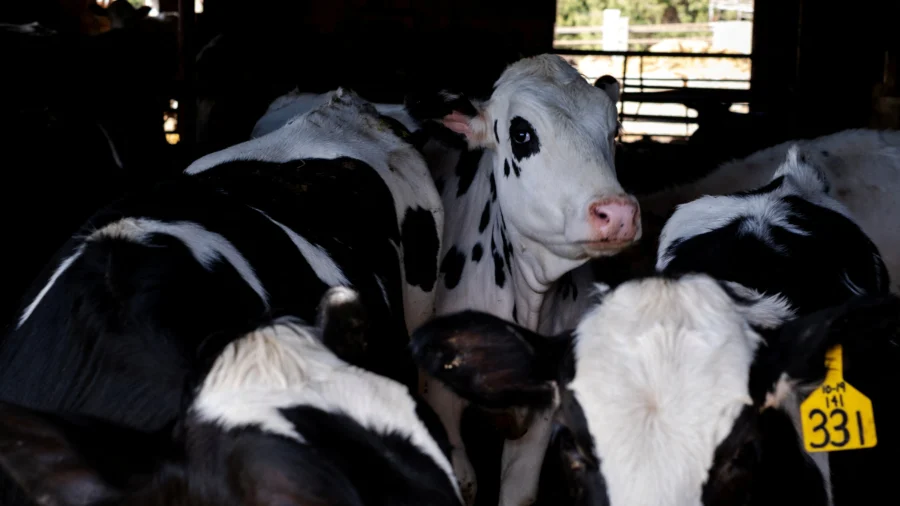The highly pathogenic avian influenza has been confirmed in dairy cattle herds in Iowa and Minnesota, authorities say, taking the number of U.S. states with cases of the influenza in cows to 11.
Testing confirmed the influenza in cattle in O’Brien County, the Iowa Department of Agriculture and Land Stewardship said on June 5.
The U.S. Department of Agriculture (USDA) performed confirmatory testing, the agency added.
“Given the spread of highly pathogenic avian influenza within dairy cattle in many other states, it is not a surprise that we would have a case given the size of our dairy industry in Iowa,” Iowa Secretary of Agriculture Mike Naig said in a statement.
“While lactating dairy cattle appear to recover with supportive care, we know this destructive virus continues to be deadly for poultry. Our team at the department has been preparing for this possibility and will soon be announcing additional response steps to protect our flocks and herds,” he added.
The influenza, or the bird flu, has already been detected in poultry in Iowa and 48 other states.
Minnesota officials said on June 6 that cases have been confirmed in a herd in Benton County.
“We knew it was only a matter of time before this detection would reach our doorstep,” state veterinarian Brian Hoefs said in a statement. “It’s important for dairy farmers to follow the example of this herd and test sick cows. The more the animal health community can learn about this virus today through testing and research, the better we can equip ourselves to prevent infections tomorrow.”
Authorities across the United States recommend that poultry and dairy farmers limit visitors to their farms and report birds and cattle showing flu symptoms, such as difficulty breathing, to officials.
They also recommend keeping cattle separate from other species, isolating newly-arrived cattle, and heat-treating milk from cattle before feeding it to other mammals.
“This remains an evolving situation and we will continue to be in close communication with stakeholders, USDA, and other states as we evaluate our response. Our top priority is to protect our livestock and the farmers and people who care for them,” Mr. Naig said.
Cases in cattle began appearing earlier this year and have since been confirmed in Colorado, Kansas, Idaho, Michigan, New Mexico, North Carolina, Ohio, South Dakota, and Texas. Human cases have also been confirmed in Michigan and Texas, with all three patients recovering. Some cases of bird flu in humans have resulted in death, including a recent case in Mexico.
There have been no signs of person-to-person transmission yet, authorities say. Genome analysis of the human cases in the United States points to transmission from cattle, according to the U.S. Centers for Disease Control and Prevention.
House Mice Test Positive
Eleven house mice tested positive for the bird flu, all in Roosevelt County in New Mexico in late May, the USDA’s Animal and Plant Health Inspection Service reported this week.
The cases are believed to be the first house mice, although mice are commonly used in laboratory experiments for the bird flu and other viruses.
“It is interesting that this is happening, usually wild type mice are pretty refractory to influenza virus infection. It may be worth looking into rats in dairy farms or places with large bird die-offs,” Florian Krammer, a professor in the department of microbiology at the Icahn School of Medicine at Mount Sinai in New York City, wrote on social media.
Hundreds of bird flu cases in mammals in the United States have been confirmed by the USDA since mid-2022, including cases in foxes, domestic cats, and raccoons.
The bird flu was detected in alpacas for the first time in May on a farm in Idaho.
Four of the 18 alpacas at the farm initially tested positive. Two more tested positive later, USDA officials said in a new update.
Although all of the alpacas have survived so far, most animals with confirmed cases in the United States have died or been killed, including six of the e1 cats and all five of the goats.
Richard Webby, a virus researcher with St. Jude Children’s Research Hospital, told a briefing on June 4 that experts are worried about the cases because of the possibility the virus will adapt and gain new features.
“We think while these viruses are heavily circulating in wild birds, there’s not much pressure on those viruses to change,” he said. “When they get over to these mammalian hosts—at least theoretically speaking—that’s where the most pressure on these viruses that change will occur. So lots of worries in terms of these mammal infections.”
From The Epoch Times

